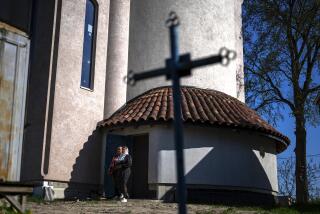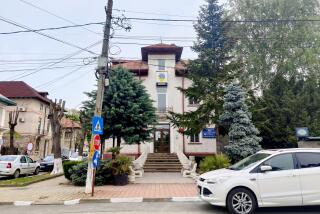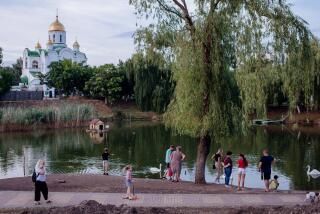Destination: Romania : Romania’s Holy Treasures : A journey into the remote foothills of Bukovina to see five famous 16th-Century churches--their outside walls covered with frescoes--and little-changed village life
- Share via
VORONET, Romania — If not for the concrete utility poles that lean beside every road and byway, a visitor to Bukovina might be forgiven for suspecting that the last few centuries never happened.
Horse-drawn carts are the chief mode of transportation on the narrow, winding roads of hard-packed gravel. Peasants plod their fields in hand-stitched boots, fashioned from the skins of slaughtered livestock. The air is pungent with fermenting plum juice as tuica brandy ages in wood barrels, and kerchiefed women gossip around the stone walls of ancient village wells. Even the wafting voices of Romanian Orthodox nuns singing their evening prayers at the monastery here seem to hearken back to a scene from the Middle Ages.
Time has almost stood still here in the hills of little-known Bukovina, a remote northern reach of Romania bejeweled with medieval monasteries uniquely adorned with outdoor frescoes.
The brightly colored scenes from the Bible are among the earliest known expressions of pop art, having been painted in the 16th Century on the exterior walls of the monastery churches for the religious education of the masses, who lacked the status to worship with the privileged class inside.
For most of the last century, Romania’s history of occupationpand repression kept the painted monasteries locked away from all but the most determined visitors. Only those willing to persevere through the Communist-era bureaucracy obtained visas and space on closely controlled government tours.
But communism’s overthrow in Eastern Europe and the repatriation of church property have allowed the art treasures to be restored to the public that they were designed for. The growth of touring opportunities and access to religious sites for the faithful have inspired the Eastern Orthodox clerics to embark on a costly project to ensure the preservation of Bukovina’s unique treasures.
Although crime is on the rise in Romania as it is elsewhere in the former communist world, rates remain comparably lower than in developed Western countries, and those traveling with a guide from a reputable travel agency should feel relatively secure. A trip to Bukovina still demands diligence and an open mind about creature comforts, since most tourist facilities have not yet reached Western European standards, but the reward is a cultural experience unparalleled.
As The Times correspondent responsible for Eastern Europe, I had been distracted for three years by the grinding war in the Balkans and was overdue for a visit to less violent venues behind what was once the Iron Curtain. My Romanian assistant Diana and I began our journey last September in Bucharest, the Romanian capital, where we rented a Toyota Corolla for about $90 per day with unlimited mileage--the most expensive investment by far for our four-day journey but the most enjoyable way to tour Romania, as the scenery waxes between pleasant and stunning along the drive north.
Bukovina is a verdant highland rising between the Bistrita and Siret rivers in the northeastern corner of Romania. The northern half of the province was lost to Ukraine in 1941, when Soviet dictator Josef Stalin annexed it and the eastern part of the neighboring province of Moldova.
Because Bukovina is so rugged and distant, it managed to escape the late tyrant Nicolae Ceausescu’s crazed campaign for industrialization. Bukovina remains a bucolic wonderland of fir trees, orchards and fields striped in emerald and chocolate.
And tucked into five remote villages of the province are the brilliantly fresco-bedecked monasteries that have earned the designation of protected art treasures by the United Nations Educational, Scientific, and Cultural Organization, UNESCO.
Bucharest travel agencies are most likely to steer foreign tourists into their group visits to Bukovina via the national airline Tarom, a white-knuckle flight from the capital usually avoided by the cognoscenti. Most groups stay overnight in the northern city of Suceava, then travel by bus to the five painted monasteries--all in one day.
But more adventurous, and leisurely, travelers might prefer a self-driving tour with a Romanian-speaking guide along--a service that can be contracted for about $30 per day. Though usually only two lanes, roads are well maintained and clearly signed, even in the most remote reaches. Gasoline is cheap by European standards at about $1 per gallon, and pumping stations are sufficiently located along the way at no more than 50-mile intervals. And best of all, the freedom of car travel also allows the visitor to take in the highlights of Transylvania along the way, following the footsteps of Vlad Dracula the Impaler and exploring the terrain that inspired Bram Stoker’s tale of the namesake vampire, Count Dracula.
After two days of Dracula touring, we left behind Transylvania at Tihuta, or Borgo Pass, scene of Stoker’s fictional Castle Dracula, and followed the undulating hills and valleys from the town of Vatra Dornei through the storybook villages that flank the roadway toward Cimpulung Moldovenesc.
The first of the painted churches one encounters when approaching from the west is Moldovita, in the middle of a Romanian farming village, and surrounded by fortress walls like all of the Bukovina monasteries. They were built in the 15th and 16th centuries, when the region was perpetually under attack by Turks, Tatars, Poles and the armies raised by regional noblemen.
We arrived in the late afternoon on a September weekend, after a rough final stretch of six or eight miles over steep gravel roads that must be taken at a snail’s pace. The weather was mild, the air refreshingly clear after the smog of Bucharest and the sun still high enough over the horizon to illuminate the exterior frescoes.
Most of the peasant women who bring hand-painted eggs and wood trinkets to sell to tourists at the monastery gate each morning had already given up and gone home.
But Sister Eupraxia, nestled into a wood booth festooned with icon key chains and postcards, was still at her post, waiting to collect 300 lei (about 18 cents) from my two Romanian traveling companions and 1,000 lei (59 cents) from me to gain entrance to the Moldovita church and the monastery buildings arrayed around it.
The entrance fee disparity is a case in point. Throughout Romania, accommodation and entry fees for Romanian nationals are only about one-third of the price charged foreigners--a further inducement to taking along a guide who can ask directions, negotiate with private homeowners for meals and rooms, and, in the event of road trouble, arrange a tow or auto repairs. Meals, for both locals and foreigners, are so reasonable as to approach the ridiculous.
Moldovita (which means a little piece of Moldova) was built in 1532 by the son of Stephen the Great. It is the largest, and arguably the best preserved, of the five Romanian Orthodox churches with external frescoes. Although part of the southern face of the church was under scaffolding as art preservation experts worked on protecting the icons from further erosion, the setting remained idyllic and conducive to a long thoughtful rest on the log benches positioned in front of the church within the walled fortress.
Wrought-iron railings edge flower beds planted between stone walkways. A pepper-pot tower rises from one corner of the surrounding fortifications and the pitched roof extending the length of the walls is edged with crenulated wood.
Livia Nichoteanu, one of the 30 Romanian Orthodox nuns living in a cluster of cottages outside the monastery walls, explains that a small livestock farm and vegetable garden sustain the convent, which is saving the entry fees and proceeds of candle sales to help with the preservation effort. The meager entry fee gains a visitor unlimited time inside the church to pore over the icons and murals of the low-ceilinged interior.
At Sucevita, a half an hour’s drive north from Moldovita, the church is dwarfed by a profusion of turrets, bell towers and lookouts with slate roofs and timbered stairways that form the four sides of the surrounding walls of the fortified monastic enclosure.
Sucevita boasts the greatest number of icons and frescoes, depicting virtually the whole of the Bible and completely covering the church exterior. It also bears witness to a medieval legend, as one buttress arch remains unpainted. Local lore holds that the artist fell to his death from an elevated work platform and the facade was left unfinished in his memory.
With sunset less than an hour away, we hurried back along the road south toward Gura Humorului to see the church and surrounding fortress in the tiny village of Voronet in its most flattering light--the vertical slants at the end of the day that most movingly illuminate the frescoes. Built in 1488 to celebrate a battle victory by Stephen the Great, Voronet (pronounced Vor - o - NETS ) is for many the most inspiring of the five churches, with its signature blue background casting each biblical scene in a heavenly hue. It is this monastery that gave the art world the color called Voronet blue, a dark sky-blue. The stone church with its plaster walls and fresco coat of art treasures sits like a small single-story cross in the grassy interior within the wood-roofed walls of the fortress.
A novitiate who stands guard at the arched passage through the walls to the grassy interior explains that the pictures have retained their bright colors, despite more than five centuries of rain, wind and sun. Their resistance to fading is believed to be due to the composition of the pigment, which she and other nuns insist has yet to be deciphered by scientists who have analyzed its composition.
“We want to make sure it survives in its current splendor. But the experts’ calculations say it could cost as much as $100 per square centimeter (about $650 per square inch),” to restore all of the murals, says the novitiate, who demurs when asked her name and cites a figure the nuns would need another five centuries to earn enough from the entrance fees.
Some aid from outside has been promised, she said, in particular, grants from UNESCO for art restoration experts.
As darkness fell, we belatedly began the search for a place to sleep--a task a wiser traveler would have taken on in the light of day. It’s customary for villagers with rooms to rent to post a watch by the monastery entrance until closing time, approaching visitors who arrive apart from tour groups to inquire whether they need a place to stay. The nuns also can make recommendations on private homes they know to be clean and safe.
But we’d talked too long with the novitiate and those with rooms to offer had all gone. We retraced our path to a quaint cluster of wood cottages we had noticed on the drive in but decided it looked like too much of a rowdy hangout.
Just before the end of the two-mile dirt road back to the town of Gura Humorului, the nearby industrial center, we spotted a whitewashed house bearing a sign reading Zimmer Frei, German for a room to rent.
Liviu Andrian, son of the owner who has furnished this villa with the wood products of the furniture factory that is his main employment, showed us three single rooms on the upper floor that were clean and nicely furnished. A blocked drain had caused water to puddle on the floor in the shared bathroom at the end of the hall, but in this remote reach of impoverished Romania it passes for about the best one can expect.
The only restaurant in Gura Humorului was less than a mile away, so we walked after so many hours cooped up in the car.
The streets were dimly lighted, but all of the town seemed to take a stroll after dinner, so it didn’t feel unsafe.
The restaurant, however, was crowded with glassy-eyed men sitting among forests of bottles. We decided to fetch picnic supplies from a small “nonstop” we had walked past, and took the cheese, bread and fruit back to our lodgings.
It proved a good choice; our host built a fire for us and, after being induced to join us, ferreted out a bottle of puckery sweet Romanian “champagne.” For 15,000-lei per room, less than $10, it was a pleasant stay, except for the train at 4 a.m. that passed noisily and closely.
*
The first few hours after sunrise also cast the painted churches in all their splendor, and we caught Humor, less than 10 miles away, when the dew still hung thickly on the lawns and the branches of towering evergreens sprinkled the frescoes with shadow play.
Humor was shut down by the occupying Austro-Hungarian Catholics in 1785, and a succession of repressive leaders kept the church and monastery within the surrounding walls in mothballs until Romania’s anti-Communist revolution of 1989, said Sister Niculina, a novitiate with a background in art history.
She explained that the exterior walls at Humor were painted in the Byzantine style in 1535, five years after the church construction, by Toma Zugravul, the only artist known to have signed his work on the Bukovina frescoes. The name Toma is etched into the forehead of a warrior at about eye level to the right of the archway leading to the church door.
The route to Arbore, the last and most remote of the painted churches, is as much a treat for the eyes as the monastery itself.
Although some maps suggest there is a road leading straight from Humor north to Solca, from which it is a short 10-minute drive to Arbore, that route is more suited to four-wheel-drive vehicles and four-legged beasts.
Going back through Gura Humorului, then veering north at the town of Patinoasa, the road passes through a gorgeous valley of grassy copses, orchards and forests, straightening after Solca to take the traveler into the heart of the village of Arbore.
Still uninhabited even five years after its reopening following the revolution, Arbore’s interior is closed most of the time, but a gate through the surrounding wall is opened and shut by a local caretaker to allow travelers a look at its outer artworks.
The town and monastery are named for one of Stephen the Great’s generals, Luca Arbore, who is entombed inside the church.
Arbore’s frescoes seem to have suffered more erosion than the other churches’, with the wall facing the gateway almost denuded of color. But the dominant green shades of the paintings on the rest of the exterior have held up better, retaining the detailed depiction of Old Testament stories.
At the end of our art exploration, we found it difficult to pull away from Arbore, where life seems to have maintained the humble simplicity of the time when the churches were erected and painted. It was in the sun-splashed courtyard of the monastery, with its backdrop of passing hoofbeats, that the journey seemed most like time travel. And the eight-hour drive back to smoggy Bucharest did not beckon.
Williams is chief of The Times’ Moscow bureau. (BEGIN TEXT OF INFOBOX / INFOGRAPHIC)
GUIDEBOOK: Roaming Romania
Getting there: Delta and Lufthansa have connecting service from Los Angeles to Bucharest; round-trip restricted fares start at about $1,060 with tax. Once in Bucharest, the national carrier, Tarom, flies to Suceava twice daily except on weekends; one-way fare is about $45. Group bus trips to see the churches are arranged by the larger Bucharest travel agencies, with interested individual travelers often fitted into any extra seats on short notice. For those who prefer to drive, reliable Western-made compact cars can be rented in Bucharest for about $90 per day with unlimited mileage, the latter a must for the more than 800-mile round-trip journey. Unless you happen to speak Romanian, it’s best to arrange an English-speaking guide through a Bucharest travel agency, such as ONT-Carpati, for about $30 per day.
Where to stay: Suceava is the base most often used by bus tour groups. The arranging agency will choose from among the handful of clean but down-at-the-heels hotels in this dispiriting industrial city. Those traveling by car will find cozier lodgings around each of the monasteries, where locals have learned to take advantage of the opportunities afforded by the new capitalist age. A clean room with breakfast (bread, butter, cheese and syrupy coffee) seldom costs more than $10 per night. If you drive, a convenient overnight stay en route to Bukovina is Tirgu Mures, where the Hotel Continental offers comfortable rooms for about $50 and a surprisingly good restaurant with traditional Transylvanian fare for about $5 per person.
Where to eat: Private homeowners renting out rooms invariably tend their own gardens and henhouses, and usually will eagerly prepare a meal for a few extra dollars--one far more likely to please than anything you’ll find in the larger restaurants that are still owned and poorly managed by the state. Picnicking is the best option for travel days, as good produce, cheese and bread can be purchased at farmers’ markets.
For more information: Kaven Travel, Los Angeles, tel. (310) 532-9999; U.S. International Tours, Chicago, tel. (312) 404-0990, or Volare Tours, New York, tel. (212) 768-1313. Or call the Romanian National Tourist Office, 342 Madison Ave., Suite 210, New York, NY 10173; tel. (212) 697-6971.
More to Read
Sign up for The Wild
We’ll help you find the best places to hike, bike and run, as well as the perfect silent spots for meditation and yoga.
You may occasionally receive promotional content from the Los Angeles Times.







